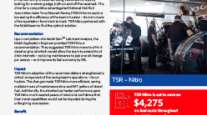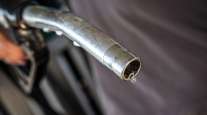Diesel Rises 1.2¢ to $2.943 a Gallon
This story appears in the Sept. 20 print edition of Transport Topics.
The average cost of a gallon of diesel fuel in the United States rose 1.2 cents last week to $2.943 a gallon, the first increase in five weeks, the Department of Energy reported.
The Sept. 13 report by DOE’s Energy Information Administration also said the retail gasoline average rose 3.9 cents to $2.721 a gallon, after falling 10.1 cents over four weeks.
Despite the moderate declines in recent weeks, prices remain well above their year-ago levels, with diesel sitting 30.9 cents higher than the corresponding week in 2009 and gasoline 14.4 cents higher.
The increases last week, according to market watchers, could indicate the beginning of a ramp-up in prices.
“There was real gloom about the economy not doing as well as [was] thought earlier, and worldwide demand wouldn’t be as high, but now I think there’s a little more optimism about the economy globally,” said EIA economist Neil Gamson.
Jim Apa, CEO of Fore Transportation Inc., Harvey, Ill., said that while his 175-truck fleet is seeing “a lot of sideways action,” he’s expecting pump prices to increase.
“It is a commodity that’s based on people who buy the fact and sell the rumor,” Apa said. “Now that the economy is surging, and in my business we’re very busy . . . why isn’t fuel back up to $4, $5, $6 a gallon? I grew 50% from last year to this year — why didn’t my fuel prices go up?”
Ron Niemoth, chief financial officer of Seward Motor Freight Inc., Seward, Neb., said, anecdotally, prices “have been going up the last few weeks again at the pump.”
Niemoth said he hasn’t seen business picking up, and he attributed the increases to “speculators looking at the market and speculating that business is going to pick up in the future.”
Both Apa and Niemoth said they were relying on fuel surcharges and technology improvements to keep them afloat.
Even though he expects increased prices, Apa said, he was not doing anything to hedge against future purchases.
“We have 175 trucks, and between my company drivers and owner-operators, we probably buy 30,000 to 35,000 gallons [of fuel] a week, so it doesn’t justify us to hedge anything,” Apa said. “I have better uses for my money.
Rather than “tie up $75,000 in premiums . . . I could take that and invest in biodiesel or invest in better technology, or there’s a turnpike system that will help me with my hard braking and increase my fuel economy by half a gallon per mile,” he said. “Those are the places smaller fleets like ours should put their money.”
Crude oil prices early last week spiked as high as $78 a barrel on the New York Mercantile Exchange after reports from China showed increases in industrial production in August and analysts’ predictions that global oil supplies would tighten through the rest of the year.
“We expect the supply-demand balance to continue to tighten in the second half of 2010 as continued global economic growth, albeit likely at a slower pace, continues to strengthen demand,” Goldman Sachs Group Inc. analysts said in a Sept. 13 report that predicted per-barrel prices of between $85 and $95 later this year.
Crude oil prices eased later in the week, closing at $74.54 a barrel on Sept. 16, even after EIA reported that gasoline and diesel stockpiles fell in the latest week.
EIA’s report, which was issued Sept. 15, said that stockpiles of distillates, including diesel fuel, declined by 340,000 barrels, about 2%, to 174.8 million barrels, and gasoline inventories dipped by 694,000 barrels to 225.2 million.
EIA’s Gamson said it was likely that gasoline prices rose more in the past week because diesel inventories are shrinking more slowly than gasoline stockpiles.
Bloomberg News contributed to this report.




